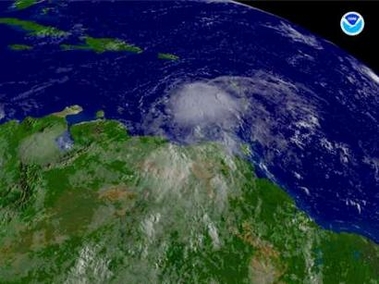MIAMI - The fifth tropical storm of the Atlantic hurricane season, Ernesto,
formed in the Caribbean on Friday and could become a hurricane threatening U.S.
oil and gas platforms in the Gulf of Mexico on the anniversary of Hurricane
Katrina, forecasters said.

The fifth tropical storm of the
Atlantic hurricane season, Ernesto, seen in this NOAA image from August
25, 2006, formed in the Caribbean on Friday and could become a hurricane
threatening U.S. oil and gas platforms in the Gulf of Mexico on the
anniversary of Hurricane Katrina, forecasters said.
[Reuters] |
The governments of Haiti and Jamaica issued storm watches, and the U.S.
National Hurricane Center said residents of the wealthy Cayman Islands and of
western Cuba should also be on guard.
Tropical storms do not have powerful winds, but they can bring heavy rains
that pose a danger for undeveloped nations, like Haiti, with poor building
standards.
Energy traders also watched the storm because of the potential for it to
strengthen as it neared the Gulf, where hurricanes temporarily knocked out much
of U.S. crude oil and natural gas production last year. The Gulf provides about
a quarter of U.S. oil and gas output.
The Miami-based hurricane center forecast that Ernesto would become a
Category 1 hurricane, with 65-knot, or 74-mile-per-hour (119-km-per-hour),
winds, by Monday, a day before the anniversary of Katrina, which devastated New
Orleans and killed about 1,500 people.
The Gulf waters this year are particularly warm. Warm waters are the fuel
hurricanes need to gain power.
"There is a chance that Ernesto could be much stronger than currently
forecast over the Gulf of Mexico," hurricane center forecaster Jack Beven said
in a bulletin on the storm.
By 5 p.m. (2100 GMT), the center of Ernesto was 300 miles (485 km)
south-southwest of San Juan, Puerto Rico, and moving toward the west-northwest
at 16 mph (26 kph).
Sustained winds were about 40 mph (65 kph).
The system could drop 3 to 6 inches (7.6 cm-15.24 cm) of rain over Jamaica
and Hispaniola, the island shared by Haiti and the Dominican Republic, and 1 to
3 inches (2.5 to 5 cm) of rain on parts of the Netherlands Antilles and Puerto
Rico.
In the eastern Atlantic, Tropical Storm Debby was barely clinging to tropical
storm status with 40 mph (64 kph) winds.
The Atlantic hurricane season, which runs from June 1 to November 30, has
been relatively quiet, with five tropical storms and no hurricanes. But activity
usually revs up between mid-August and late October.